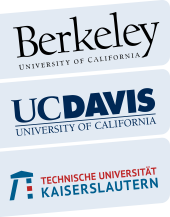

RESEARCH PROGRAM
Title: Generation of multi-material Finite Element Meshes through interactive segmentation
Name: Dr.-Ing. Peter Salz
(former student)
Project description:
Starting situation
To conduct numerical simulations of manufacturing processes or properties of machines and products, it is usually necessary to construct a threedimensional finite element mesh. These meshes either describe a material boundary by triangles, or the volumetric structure by tetrahedra. Often, multiple materials with different properties are considered. The construction of such meshes is often a tedious process, so many simplifications and approximations are used, sacrificing precision and significance of the simulations.
Approach
We consider cases where the object of study can be described by a 3D scalar field, such as industrial Computed Tomography imagery. There, the object’s density at each voxel is given with high precision and spatial resolution. Our approach was first developed for the medical field, realising patient-specific thorax models for lung imaging. We propose an interactive segmentation workflow which allows the delination of different objects, structures, or materials in the volume data. Many existing approaches rely mostly on gray value thresholding and other morphological image processing methods, while our workflow explicitily encodes expert knowledge regarding object membership, regardless of the voxel values. Once such a multi-material segmentation of the object is generated, we can convert it to a finite element mesh using either triangles or tetrahedra, respecting the material transitions and application-specific needs for mesh adaptation.
Expected Results
From this project we expect to construct meshes for numerical simulations of industrial processes and machines with very high precision in reduced time, thus allowing more simulations with a diverse set of meshes. In addition, our proposed method is in general not restricted to 3D scalar fields, but is expected to be easily adaptable to other input data, such as stereoscopic imagery or laser scans.

Adaptive, multi-material, tetrahedral mesh of a lung and heart, generated by an early version of our proposed approach.
Taken from Salz: Towards Patient-specific Electrical Impedance Tomography using 3D Thorax Models, 2014, Dissertation

